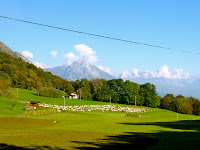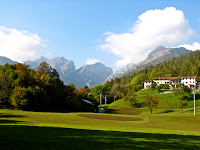A small group of students and I visited Modena last weekend, which is also in the region of Emilia Romagna. A couple people really wanted to visit the Ferrari museum right outside of town, so I was ready to tag along and then explore more of Modena and its balsamic vinegar tradition afterwards. The Galleria Ferrari was highly overrated as you basically you pay eleven euro to take pictures of cars. Not really being a car aficionado, I didn't really appreciate it fully.
 Ready to get going we stopped in a couple Ferrari apparel shops, looked at a couple 100euro t-shirts, and headed back to the bus stop. Now, before coming I had looked up information in my guide book on the Galleria Ferrari, including which bus to take to get there. The guide book had extremely oversimplified the process, leaving us very confused, but we still managed to get to the Galleria by asking various bus drivers. However, getting back proved to be much more difficult. For whatever reason, it turned out that the bus didn't stop at the same place to go BACK to Modena, which took us a good forty-five minutes to figure out. We walked for a bit and found another stop to which, after another twenty minutes, a bus came. Once we started getting on however, the bus driver told us that we couldn't buy bus tickets on the bus, although we had been previously told otherwise. After some confused discussion, the driver decided it was less trouble for him to just let us on the bus without paying. By the time we got back to Modena and got situated, it was about 4:00pm and raining pretty steadily. We walked around for a bit, saw a cathedral as well as the Palazzo Ducale in centro, then headed back to the train station. I didn't get do the balsamic experience, however Modena is an easy 6euro train ride away and I can always go back.
Ready to get going we stopped in a couple Ferrari apparel shops, looked at a couple 100euro t-shirts, and headed back to the bus stop. Now, before coming I had looked up information in my guide book on the Galleria Ferrari, including which bus to take to get there. The guide book had extremely oversimplified the process, leaving us very confused, but we still managed to get to the Galleria by asking various bus drivers. However, getting back proved to be much more difficult. For whatever reason, it turned out that the bus didn't stop at the same place to go BACK to Modena, which took us a good forty-five minutes to figure out. We walked for a bit and found another stop to which, after another twenty minutes, a bus came. Once we started getting on however, the bus driver told us that we couldn't buy bus tickets on the bus, although we had been previously told otherwise. After some confused discussion, the driver decided it was less trouble for him to just let us on the bus without paying. By the time we got back to Modena and got situated, it was about 4:00pm and raining pretty steadily. We walked around for a bit, saw a cathedral as well as the Palazzo Ducale in centro, then headed back to the train station. I didn't get do the balsamic experience, however Modena is an easy 6euro train ride away and I can always go back.This past Saturday morning I decided to take the direct train one and a half hours from Ferrara to Venezia for a small day trip. I went armed with my camera, some money, and a Lonely Planet guidebook to help me around the city. From the first steps out of the train station, I loved Venezia. I had decided to follow a suggested walking route in the guidebook that takes you in a roundabout way to Piazza San Marco by winding through some smaller, less toured streets.

Taking my time and stopping into whatever shops looked interesting, I made my way to my first stop, and perhaps my favorite: Campo di Ghetto Nuovo.
This was the area to which the city's Jewish population was ordered to move in the early 1500s. This small "island" was locked at night and the inhabitants were forced to follow strict laws limiting social and economic activity. It wasn't until almost 1800 that the Jews were allowed to live outside of this area. In this area now there are stores selling Jewish goods, monuments for the Jewish population sent from Venezia to concentration camps in WWII, a good amount of synagogues, and Kosher restaurants. It was really incredible to see a piece of history still so much like it was hundreds of years ago.

 After the ghetto, I walked towards my next destinations, a couple cathedrals including the city's Jesuit cathedral, La Chiesa dei Geuati, then later the Chiesa dei SS Giovnni e Paolo, and the Chiesa di Santa Maria Formosa--none of which I went into since all had an admission fee, but all of which were extremely impressive to look at from outside.
After the ghetto, I walked towards my next destinations, a couple cathedrals including the city's Jesuit cathedral, La Chiesa dei Geuati, then later the Chiesa dei SS Giovnni e Paolo, and the Chiesa di Santa Maria Formosa--none of which I went into since all had an admission fee, but all of which were extremely impressive to look at from outside. I wandered around for a bit in the shops between the neighborhoods of the Castello and San Marco before finally making my way to the famed Piazza San Marco around sunset. It was packed with people and, with the light falling, I decided to take the vaporetto (ferry) up the Grand Canal back to the ferrovia (train station)
Overall, one of my main impressions of Venezia is that it is quite well preserved and removed from urbanization. I love that it is a city with obvious wear and age, but in a very calm, refined way. I'm really happy that I went by the walking route that took me off-the-beaten-path and also that I went in October, well outside the tourist season. I think I got a view of Venezia that not many visitors see and am hoping to return a couple more times before my stay is over!

















